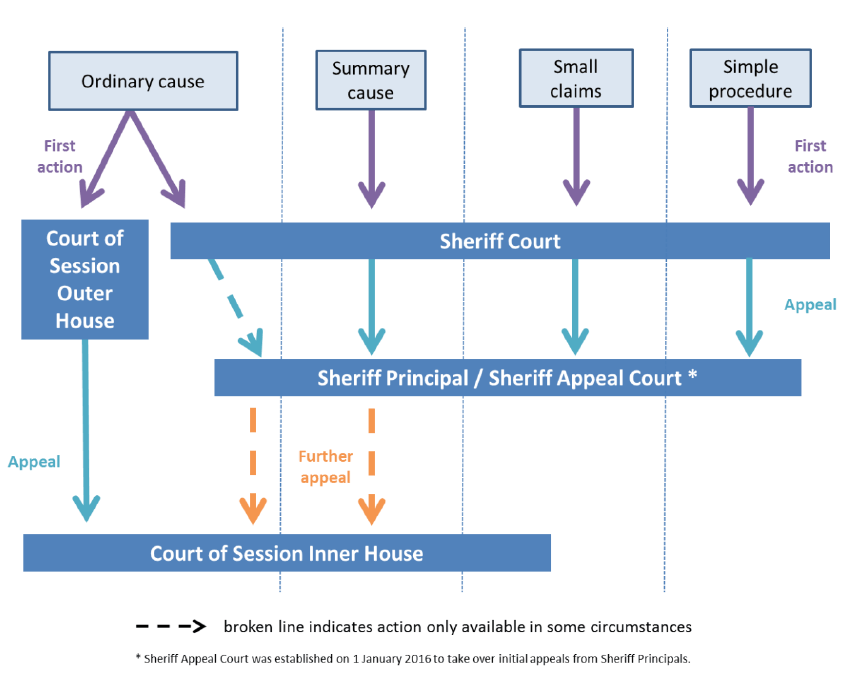Civil justice statistics in Scotland: 2016-2017
The 2016-17 Civil Justice in Scotland release includes main statistics tables and figures and supplementary statistics tables.
2. Introduction
Civil justice is concerned with the rights and obligations of people and organisations. One way of resolving civil law disputes is for a case to be brought to court. In Scotland, civil law cases are usually conducted in a sheriff court or the Court of Session. Common types of cases where civil law applies include debt, divorce and claims for personal injury.
The primary focus of this bulletin is on civil law cases in sheriff courts and the Court of Session in the financial year 2016-17. This is supported by an overview of civil court structure and procedures, a description of recent changes in legislation, a historical overview of the volume of civil law cases and a list of definitions. Civil justice statistics from the Scottish Legal Aid Board and the Scottish Crime and Justice Survey are also mentioned to provide further context. The civil justice statistics discussed in this bulletin do not include Tribunals cases.
Civil law statistics are used within the Scottish Government to inform decisions and policy-making and to monitor the impact of policies following their implementation. The statistics are also used for resource allocation by the Scottish Courts and Tribunals Service, and to support third sector activity in lobbying and funding applications. The statistics also inform the public about the business of Scottish courts and facilitate academic research on civil law.
In addition to this bulletin, the 2016-17 Civil Justice Statistics in Scotland release includes:
- Statistics tables and figures – comprising the tables and figures that appear in this bulletin
- Supplementary statistics tables – additional statistics on civil law cases in sheriff courts and the Court of Session
- Background data tables – an interactive dataset on civil law court cases by court, which can be used to generate customised tables and charts
- Statistical news release
Up until 28 November 2016, civil law court cases were carried out mainly using one of three procedures: ordinary cause, summary cause or small claims. In November 2016, the first phase of the new simple procedure was introduced into the sheriff court, this procedure replaces the small claims and the more straightforward cases under summary cause procedure. Sheriff courts also handle summary applications, which are generally applications set out in legislation, and commissary business relating to succession and access to a deceased person’s estate. The relationships between the main civil law court procedures and the civil courts are shown in Figure 2, although it should be noted that this diagram is somewhat simplified. More information can be found in the Civil courts and procedures in Scotland section. It should also be noted that court structure and procedures in Scotland are changing due to the reforms introduced by the Courts Reform (Scotland) Act 2014, which are described in more detail in Courts Reform section. Figure 2 shows the current court structure and procedures.
Figure 2: Summary of court structure

Recent changes brought in by the Courts Reform (Scotland) Act 2014 affect the statistics presented in this bulletin. The bulletin now includes statistics on the newly established Sheriff Personal Injury Court (Table 17), civil law appeals within the Sheriff Appeal Court (Table 25) and permission on civil applications to the Court of Session to appeal to the UK Supreme Court (Table 26).
Important notes on the use of civil justice statistics
The civil law court statistics presented in this bulletin relate only to the principal crave of cases. An individual case can involve a number of different case types. The case type which is listed first on the writ is normally known as the principal crave and the others are described as ancillary craves. The feasibility of publishing statistics on ancillary craves in future editions is being investigated.
The large variety of case types and procedural outcomes that can be pursued in civil law mean that recording and reporting civil law court cases accurately and reliably is a challenge. One consequence is that the number of ordinary cause and summary application cases disposed of in the sheriff court as recorded by the CMS system is an underestimate. Further work will be carried out by the Scottish Courts and Tribunals Service to determine if the disposals underestimate issue still prevails with the iCMS system. There is no evidence of any significant inaccuracies in the data for summary cause and small claims cases. More information about accuracy of the statistics and further guidance on use of the statistics is available from the Quality of the statistics section.
The statistics in the tables for initiations and disposals do not necessarily refer to the same cases. This is because not all the cases initiated in a year will be disposed of in that same year.
All statistics in this release are presented for financial years (1 April to 31 March) except where otherwise stated.
Statistics and percentages referring to cases from the civil courts in this release include the Court of Session, sheriff courts and the Sheriff Personal Injury Court unless otherwise stated.
Contact
There is a problem
Thanks for your feedback